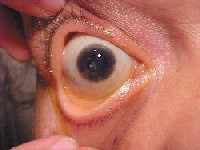 |
History
A 59-year-old black female presented for a routine eye examination with a chief complaint of scratchy eyes, which she said occurs mostly in the morning. She reported no allergies and denied taking any medications.
Diagnostic Data
Her best-corrected acuity was 20/20 O.U. at distance and near. External examination was normal with no evidence of afferent pupillary defect. Detailed inspection of the cornea revealed numerous inferior superficial abrasions and a broad, course, punctate epitheliopathy in both eyes.
Another pertinent anterior segment finding is demonstrated in the photograph.
Applanation intraocular pressures measured 18mm Hg O.U. The dilated fundus findings were unremarkable in both eyes.
 |
| A 59-year-old female had this presentation and scratchy eyes. |
Your Diagnosis
How would you approach this case? Does this patient require additional tests? What is your diagnosis? How would you manage this patient? What is the likely prognosis?
Discussion
The diagnosis in this case is floppy eyelid syndrome. Floppy eyelid syndrome is a syndrome of chronic papillary conjunctivitis in overweight patients who have easily everted eyelids.
Floppy eyelid syndrome may be the underlying cause of papillary keratoconjunctivitis. Patients initially report a nonspecific irritation, redness or a foreign body sensation. The most distinctive feature of floppy eyelid syndrome is a pliant upper tarsus that is easily everted without excess manipulation. Histopathology has attributed the laxity of the lid to a decreased amount of elastin within the tarsus.1
One study identified another physical finding in floppy eyelid syndrome: eyelash ptosis in which there is loss of eyelash parallelism.2 The authors believe that this physical finding can aid in the timely diagnosis and treatment of this sometimes obscure syndrome.2
Treatment includes preventing the upper lid from everting during sleep or surgical procedures, such as horizontal eyelid shortening.3,4 I instructed this patient to apply artificial tear ointment before going to sleep and to use a tight blindfold to protect and maintain eyelid closure while sleeping. The therapy was successful, and the patient continues it today.
1. Schlotzer-Schrehardt U, Stojkovic M, et al. The pathogenesis of floppy eyelid syndrome: involvement of matrix metalloproteinases in elastic fiber degradation. Ophthalmology 2005 Apr;112(4):694-704.
2. Langford JD, Linberg JV. A new physical finding in floppy eyelid syndrome. Ophthalmology 1998 Jan;105(1):165-9.
3. Seiff SR. Surgical management of seventh nerve paralysis and floppy eyelid syndrome. Curr Opin Ophthalmol 1999 Aug;10(4):242-6.
4. Dufek MA, Shechtman DL. Floppy eyelid syndrome: a diagnostic dilemma. J Am Optom Assoc 1999 Jul;7:(7):450-4.

